Impact of Alcohol Swabs on Healthcare
VerifiedAdded on 2020/04/21
|10
|2326
|222
AI Summary
This assignment explores the use of alcohol swabs in healthcare. It analyzes their efficacy in reducing infections, particularly during procedures like insulin injections and surgery. The assignment also investigates potential risks associated with alcohol swabs, such as allergic reactions, and compares them to alternative hand hygiene methods like soap and water. The analysis includes research papers that delve into the chemical, physical, and physiological aspects of skin antisepsis, transmission of pathogens through shared drug paraphernalia, and best practices for infection control in accordance with WHO guidelines.
Contribute Materials
Your contribution can guide someone’s learning journey. Share your
documents today.
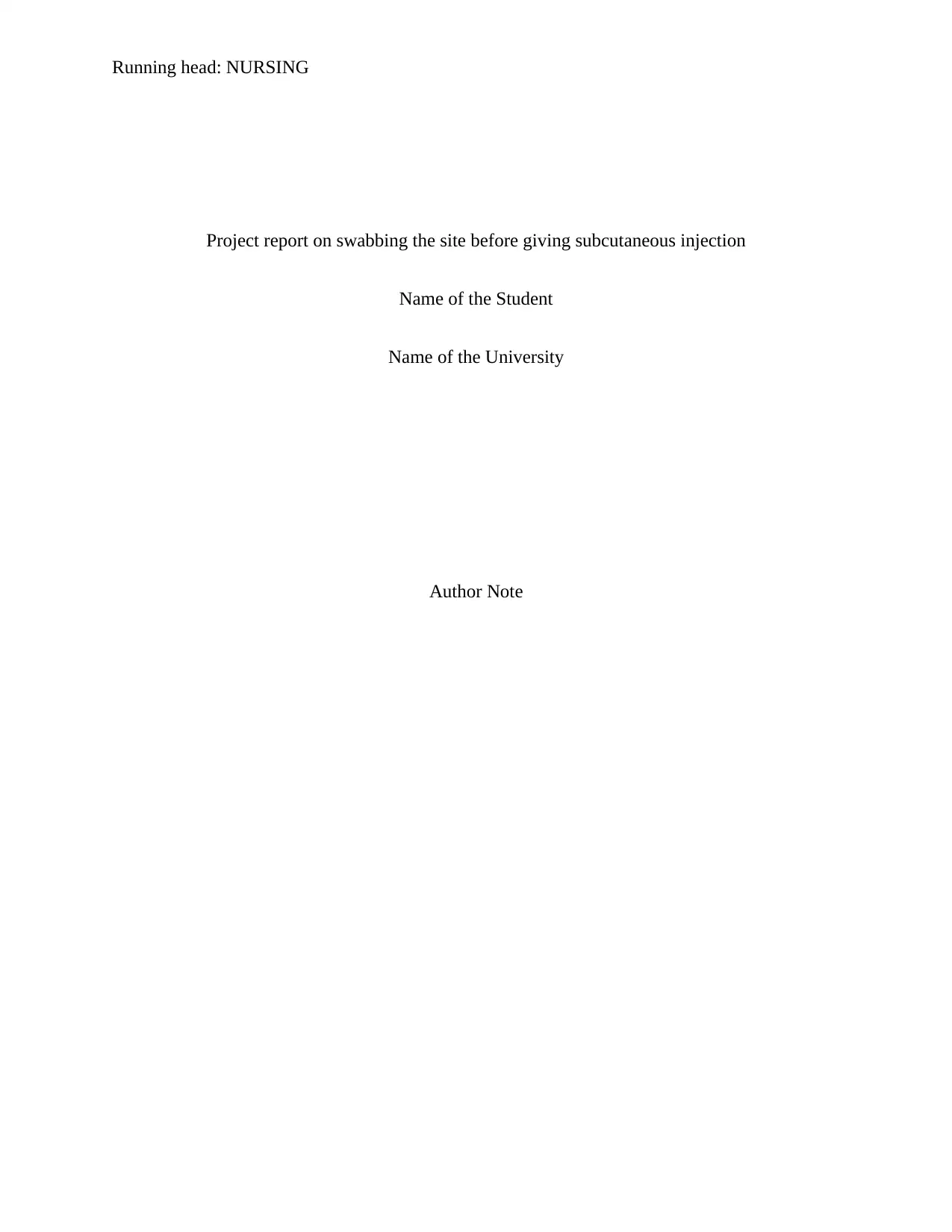
Running head: NURSING
Project report on swabbing the site before giving subcutaneous injection
Name of the Student
Name of the University
Author Note
Project report on swabbing the site before giving subcutaneous injection
Name of the Student
Name of the University
Author Note
Secure Best Marks with AI Grader
Need help grading? Try our AI Grader for instant feedback on your assignments.
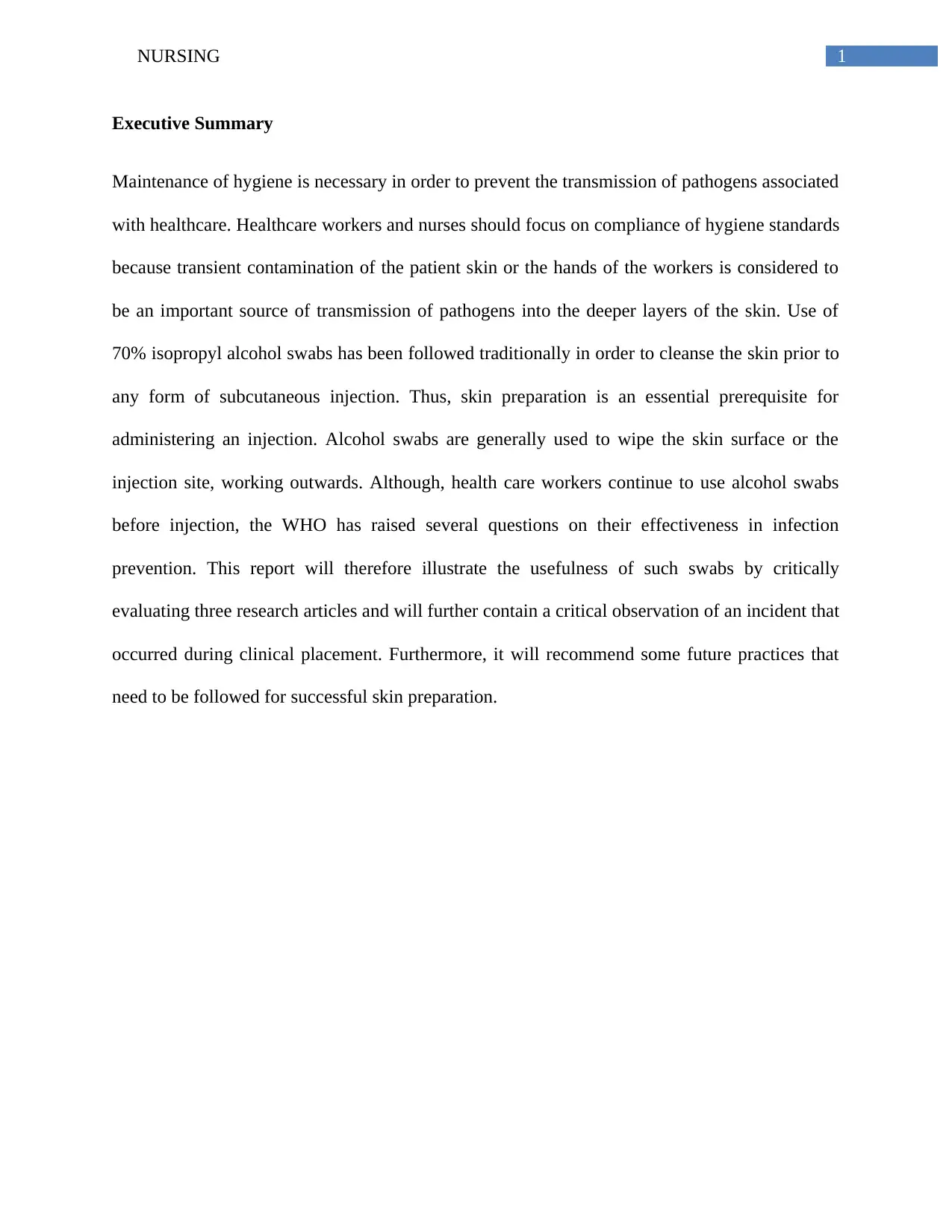
1NURSING
Executive Summary
Maintenance of hygiene is necessary in order to prevent the transmission of pathogens associated
with healthcare. Healthcare workers and nurses should focus on compliance of hygiene standards
because transient contamination of the patient skin or the hands of the workers is considered to
be an important source of transmission of pathogens into the deeper layers of the skin. Use of
70% isopropyl alcohol swabs has been followed traditionally in order to cleanse the skin prior to
any form of subcutaneous injection. Thus, skin preparation is an essential prerequisite for
administering an injection. Alcohol swabs are generally used to wipe the skin surface or the
injection site, working outwards. Although, health care workers continue to use alcohol swabs
before injection, the WHO has raised several questions on their effectiveness in infection
prevention. This report will therefore illustrate the usefulness of such swabs by critically
evaluating three research articles and will further contain a critical observation of an incident that
occurred during clinical placement. Furthermore, it will recommend some future practices that
need to be followed for successful skin preparation.
Executive Summary
Maintenance of hygiene is necessary in order to prevent the transmission of pathogens associated
with healthcare. Healthcare workers and nurses should focus on compliance of hygiene standards
because transient contamination of the patient skin or the hands of the workers is considered to
be an important source of transmission of pathogens into the deeper layers of the skin. Use of
70% isopropyl alcohol swabs has been followed traditionally in order to cleanse the skin prior to
any form of subcutaneous injection. Thus, skin preparation is an essential prerequisite for
administering an injection. Alcohol swabs are generally used to wipe the skin surface or the
injection site, working outwards. Although, health care workers continue to use alcohol swabs
before injection, the WHO has raised several questions on their effectiveness in infection
prevention. This report will therefore illustrate the usefulness of such swabs by critically
evaluating three research articles and will further contain a critical observation of an incident that
occurred during clinical placement. Furthermore, it will recommend some future practices that
need to be followed for successful skin preparation.
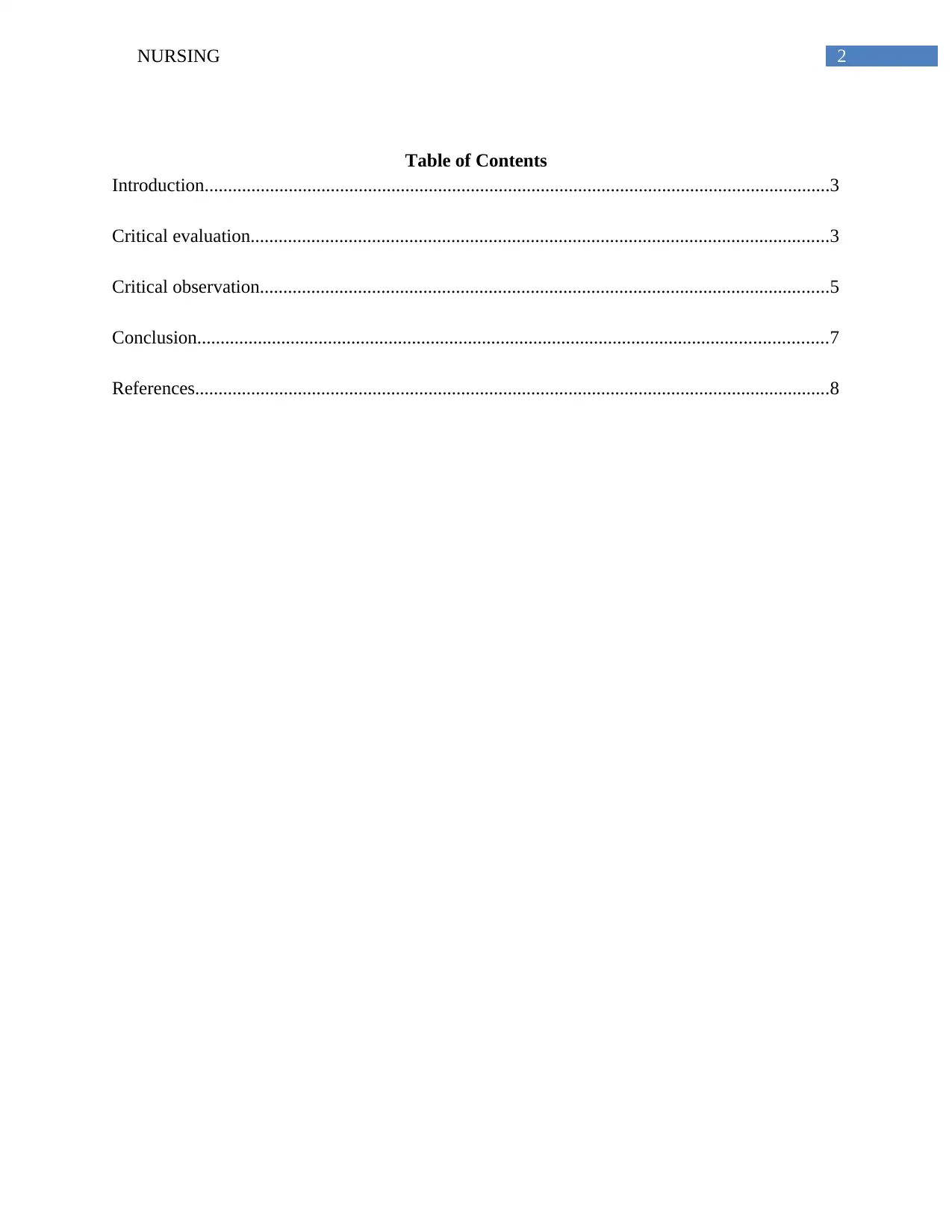
2NURSING
Table of Contents
Introduction......................................................................................................................................3
Critical evaluation............................................................................................................................3
Critical observation..........................................................................................................................5
Conclusion.......................................................................................................................................7
References........................................................................................................................................8
Table of Contents
Introduction......................................................................................................................................3
Critical evaluation............................................................................................................................3
Critical observation..........................................................................................................................5
Conclusion.......................................................................................................................................7
References........................................................................................................................................8
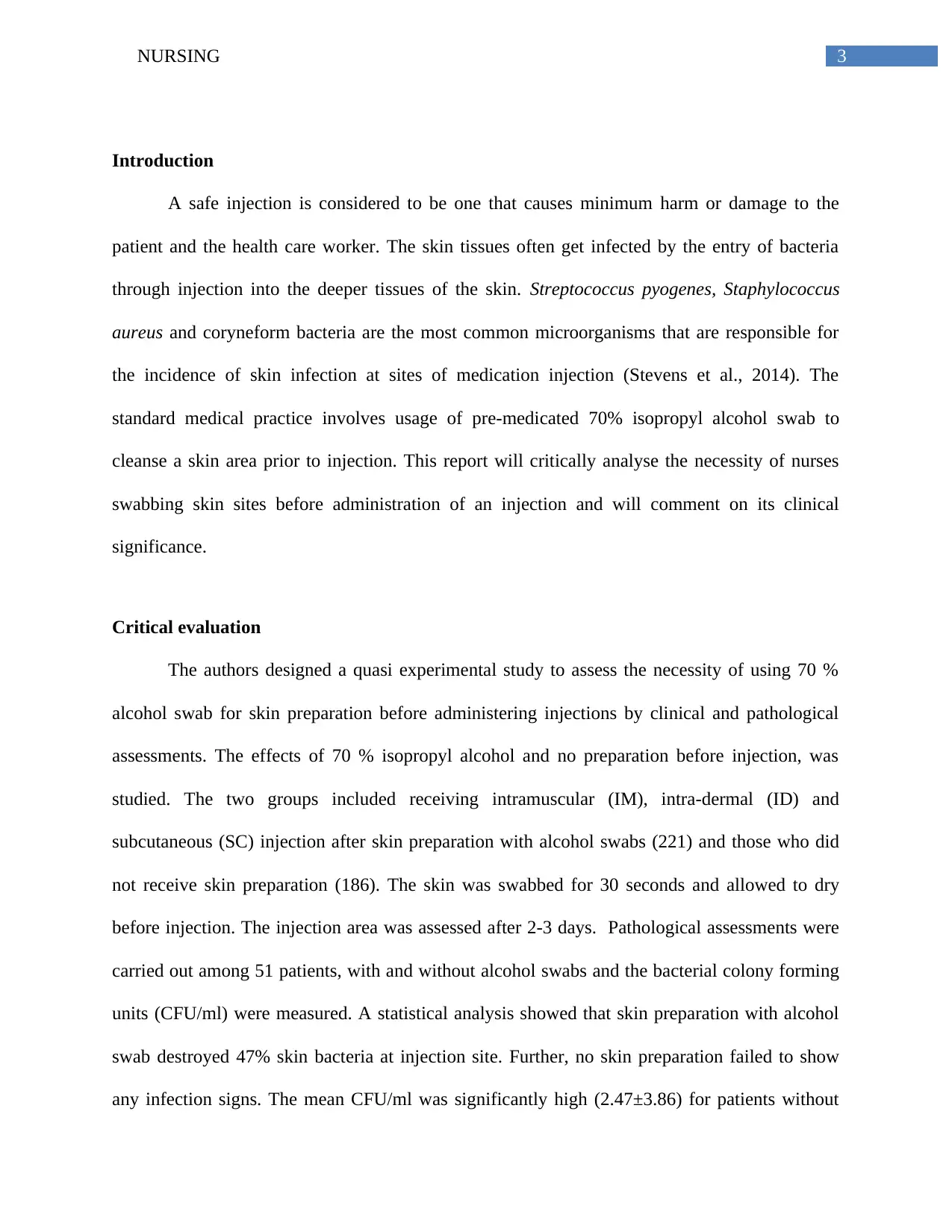
3NURSING
Introduction
A safe injection is considered to be one that causes minimum harm or damage to the
patient and the health care worker. The skin tissues often get infected by the entry of bacteria
through injection into the deeper tissues of the skin. Streptococcus pyogenes, Staphylococcus
aureus and coryneform bacteria are the most common microorganisms that are responsible for
the incidence of skin infection at sites of medication injection (Stevens et al., 2014). The
standard medical practice involves usage of pre-medicated 70% isopropyl alcohol swab to
cleanse a skin area prior to injection. This report will critically analyse the necessity of nurses
swabbing skin sites before administration of an injection and will comment on its clinical
significance.
Critical evaluation
The authors designed a quasi experimental study to assess the necessity of using 70 %
alcohol swab for skin preparation before administering injections by clinical and pathological
assessments. The effects of 70 % isopropyl alcohol and no preparation before injection, was
studied. The two groups included receiving intramuscular (IM), intra-dermal (ID) and
subcutaneous (SC) injection after skin preparation with alcohol swabs (221) and those who did
not receive skin preparation (186). The skin was swabbed for 30 seconds and allowed to dry
before injection. The injection area was assessed after 2-3 days. Pathological assessments were
carried out among 51 patients, with and without alcohol swabs and the bacterial colony forming
units (CFU/ml) were measured. A statistical analysis showed that skin preparation with alcohol
swab destroyed 47% skin bacteria at injection site. Further, no skin preparation failed to show
any infection signs. The mean CFU/ml was significantly high (2.47±3.86) for patients without
Introduction
A safe injection is considered to be one that causes minimum harm or damage to the
patient and the health care worker. The skin tissues often get infected by the entry of bacteria
through injection into the deeper tissues of the skin. Streptococcus pyogenes, Staphylococcus
aureus and coryneform bacteria are the most common microorganisms that are responsible for
the incidence of skin infection at sites of medication injection (Stevens et al., 2014). The
standard medical practice involves usage of pre-medicated 70% isopropyl alcohol swab to
cleanse a skin area prior to injection. This report will critically analyse the necessity of nurses
swabbing skin sites before administration of an injection and will comment on its clinical
significance.
Critical evaluation
The authors designed a quasi experimental study to assess the necessity of using 70 %
alcohol swab for skin preparation before administering injections by clinical and pathological
assessments. The effects of 70 % isopropyl alcohol and no preparation before injection, was
studied. The two groups included receiving intramuscular (IM), intra-dermal (ID) and
subcutaneous (SC) injection after skin preparation with alcohol swabs (221) and those who did
not receive skin preparation (186). The skin was swabbed for 30 seconds and allowed to dry
before injection. The injection area was assessed after 2-3 days. Pathological assessments were
carried out among 51 patients, with and without alcohol swabs and the bacterial colony forming
units (CFU/ml) were measured. A statistical analysis showed that skin preparation with alcohol
swab destroyed 47% skin bacteria at injection site. Further, no skin preparation failed to show
any infection signs. The mean CFU/ml was significantly high (2.47±3.86) for patients without
Secure Best Marks with AI Grader
Need help grading? Try our AI Grader for instant feedback on your assignments.
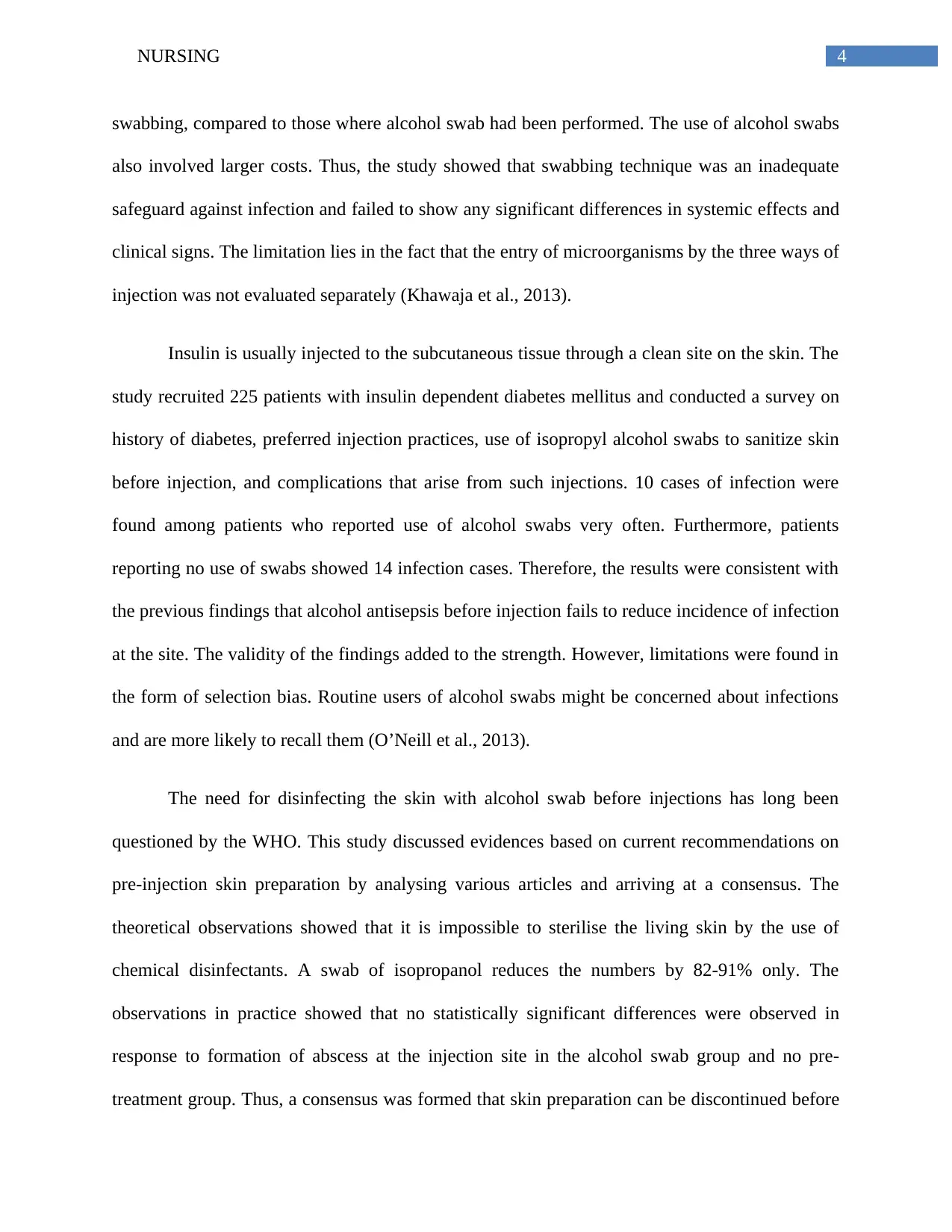
4NURSING
swabbing, compared to those where alcohol swab had been performed. The use of alcohol swabs
also involved larger costs. Thus, the study showed that swabbing technique was an inadequate
safeguard against infection and failed to show any significant differences in systemic effects and
clinical signs. The limitation lies in the fact that the entry of microorganisms by the three ways of
injection was not evaluated separately (Khawaja et al., 2013).
Insulin is usually injected to the subcutaneous tissue through a clean site on the skin. The
study recruited 225 patients with insulin dependent diabetes mellitus and conducted a survey on
history of diabetes, preferred injection practices, use of isopropyl alcohol swabs to sanitize skin
before injection, and complications that arise from such injections. 10 cases of infection were
found among patients who reported use of alcohol swabs very often. Furthermore, patients
reporting no use of swabs showed 14 infection cases. Therefore, the results were consistent with
the previous findings that alcohol antisepsis before injection fails to reduce incidence of infection
at the site. The validity of the findings added to the strength. However, limitations were found in
the form of selection bias. Routine users of alcohol swabs might be concerned about infections
and are more likely to recall them (O’Neill et al., 2013).
The need for disinfecting the skin with alcohol swab before injections has long been
questioned by the WHO. This study discussed evidences based on current recommendations on
pre-injection skin preparation by analysing various articles and arriving at a consensus. The
theoretical observations showed that it is impossible to sterilise the living skin by the use of
chemical disinfectants. A swab of isopropanol reduces the numbers by 82-91% only. The
observations in practice showed that no statistically significant differences were observed in
response to formation of abscess at the injection site in the alcohol swab group and no pre-
treatment group. Thus, a consensus was formed that skin preparation can be discontinued before
swabbing, compared to those where alcohol swab had been performed. The use of alcohol swabs
also involved larger costs. Thus, the study showed that swabbing technique was an inadequate
safeguard against infection and failed to show any significant differences in systemic effects and
clinical signs. The limitation lies in the fact that the entry of microorganisms by the three ways of
injection was not evaluated separately (Khawaja et al., 2013).
Insulin is usually injected to the subcutaneous tissue through a clean site on the skin. The
study recruited 225 patients with insulin dependent diabetes mellitus and conducted a survey on
history of diabetes, preferred injection practices, use of isopropyl alcohol swabs to sanitize skin
before injection, and complications that arise from such injections. 10 cases of infection were
found among patients who reported use of alcohol swabs very often. Furthermore, patients
reporting no use of swabs showed 14 infection cases. Therefore, the results were consistent with
the previous findings that alcohol antisepsis before injection fails to reduce incidence of infection
at the site. The validity of the findings added to the strength. However, limitations were found in
the form of selection bias. Routine users of alcohol swabs might be concerned about infections
and are more likely to recall them (O’Neill et al., 2013).
The need for disinfecting the skin with alcohol swab before injections has long been
questioned by the WHO. This study discussed evidences based on current recommendations on
pre-injection skin preparation by analysing various articles and arriving at a consensus. The
theoretical observations showed that it is impossible to sterilise the living skin by the use of
chemical disinfectants. A swab of isopropanol reduces the numbers by 82-91% only. The
observations in practice showed that no statistically significant differences were observed in
response to formation of abscess at the injection site in the alcohol swab group and no pre-
treatment group. Thus, a consensus was formed that skin preparation can be discontinued before
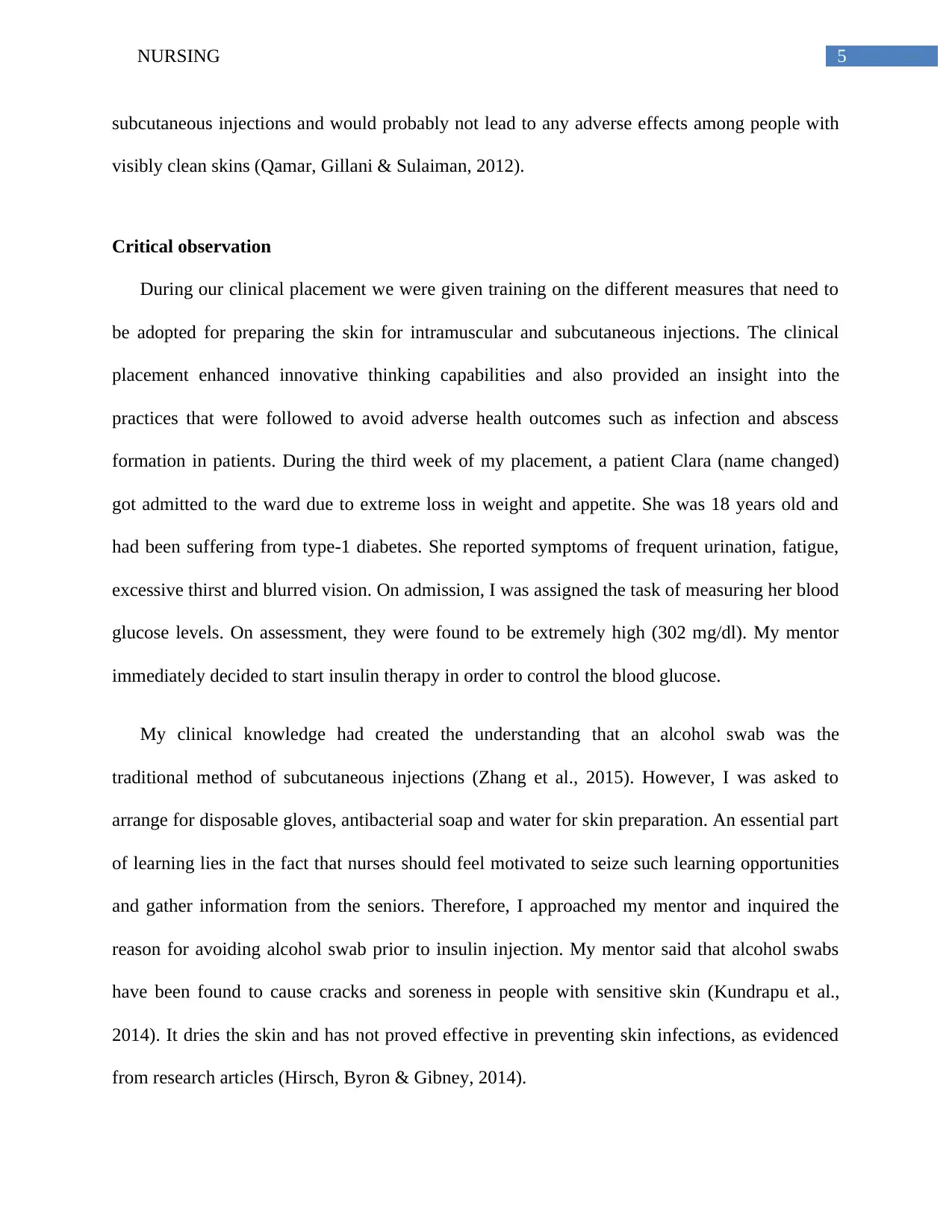
5NURSING
subcutaneous injections and would probably not lead to any adverse effects among people with
visibly clean skins (Qamar, Gillani & Sulaiman, 2012).
Critical observation
During our clinical placement we were given training on the different measures that need to
be adopted for preparing the skin for intramuscular and subcutaneous injections. The clinical
placement enhanced innovative thinking capabilities and also provided an insight into the
practices that were followed to avoid adverse health outcomes such as infection and abscess
formation in patients. During the third week of my placement, a patient Clara (name changed)
got admitted to the ward due to extreme loss in weight and appetite. She was 18 years old and
had been suffering from type-1 diabetes. She reported symptoms of frequent urination, fatigue,
excessive thirst and blurred vision. On admission, I was assigned the task of measuring her blood
glucose levels. On assessment, they were found to be extremely high (302 mg/dl). My mentor
immediately decided to start insulin therapy in order to control the blood glucose.
My clinical knowledge had created the understanding that an alcohol swab was the
traditional method of subcutaneous injections (Zhang et al., 2015). However, I was asked to
arrange for disposable gloves, antibacterial soap and water for skin preparation. An essential part
of learning lies in the fact that nurses should feel motivated to seize such learning opportunities
and gather information from the seniors. Therefore, I approached my mentor and inquired the
reason for avoiding alcohol swab prior to insulin injection. My mentor said that alcohol swabs
have been found to cause cracks and soreness in people with sensitive skin (Kundrapu et al.,
2014). It dries the skin and has not proved effective in preventing skin infections, as evidenced
from research articles (Hirsch, Byron & Gibney, 2014).
subcutaneous injections and would probably not lead to any adverse effects among people with
visibly clean skins (Qamar, Gillani & Sulaiman, 2012).
Critical observation
During our clinical placement we were given training on the different measures that need to
be adopted for preparing the skin for intramuscular and subcutaneous injections. The clinical
placement enhanced innovative thinking capabilities and also provided an insight into the
practices that were followed to avoid adverse health outcomes such as infection and abscess
formation in patients. During the third week of my placement, a patient Clara (name changed)
got admitted to the ward due to extreme loss in weight and appetite. She was 18 years old and
had been suffering from type-1 diabetes. She reported symptoms of frequent urination, fatigue,
excessive thirst and blurred vision. On admission, I was assigned the task of measuring her blood
glucose levels. On assessment, they were found to be extremely high (302 mg/dl). My mentor
immediately decided to start insulin therapy in order to control the blood glucose.
My clinical knowledge had created the understanding that an alcohol swab was the
traditional method of subcutaneous injections (Zhang et al., 2015). However, I was asked to
arrange for disposable gloves, antibacterial soap and water for skin preparation. An essential part
of learning lies in the fact that nurses should feel motivated to seize such learning opportunities
and gather information from the seniors. Therefore, I approached my mentor and inquired the
reason for avoiding alcohol swab prior to insulin injection. My mentor said that alcohol swabs
have been found to cause cracks and soreness in people with sensitive skin (Kundrapu et al.,
2014). It dries the skin and has not proved effective in preventing skin infections, as evidenced
from research articles (Hirsch, Byron & Gibney, 2014).
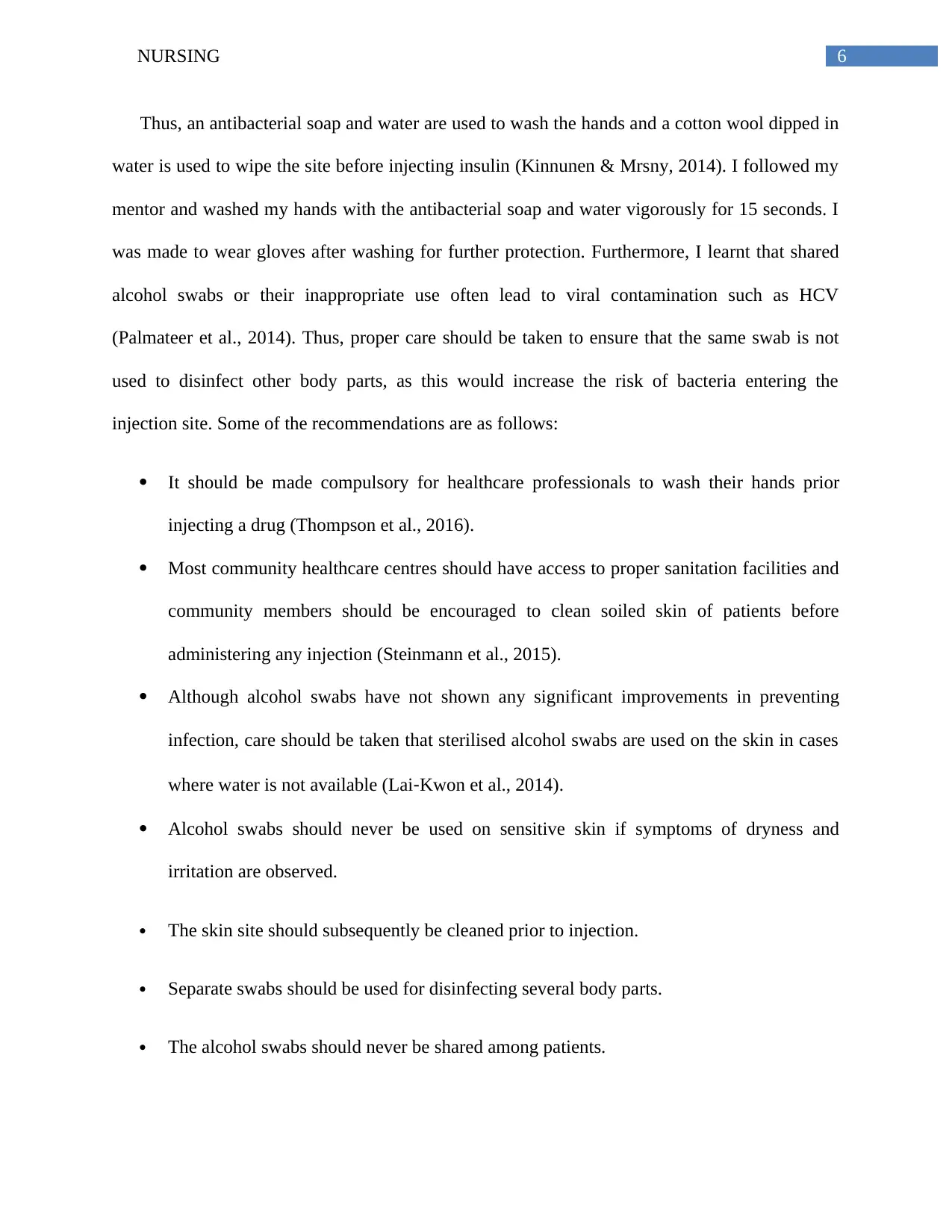
6NURSING
Thus, an antibacterial soap and water are used to wash the hands and a cotton wool dipped in
water is used to wipe the site before injecting insulin (Kinnunen & Mrsny, 2014). I followed my
mentor and washed my hands with the antibacterial soap and water vigorously for 15 seconds. I
was made to wear gloves after washing for further protection. Furthermore, I learnt that shared
alcohol swabs or their inappropriate use often lead to viral contamination such as HCV
(Palmateer et al., 2014). Thus, proper care should be taken to ensure that the same swab is not
used to disinfect other body parts, as this would increase the risk of bacteria entering the
injection site. Some of the recommendations are as follows:
It should be made compulsory for healthcare professionals to wash their hands prior
injecting a drug (Thompson et al., 2016).
Most community healthcare centres should have access to proper sanitation facilities and
community members should be encouraged to clean soiled skin of patients before
administering any injection (Steinmann et al., 2015).
Although alcohol swabs have not shown any significant improvements in preventing
infection, care should be taken that sterilised alcohol swabs are used on the skin in cases
where water is not available (Lai‐Kwon et al., 2014).
Alcohol swabs should never be used on sensitive skin if symptoms of dryness and
irritation are observed.
The skin site should subsequently be cleaned prior to injection.
Separate swabs should be used for disinfecting several body parts.
The alcohol swabs should never be shared among patients.
Thus, an antibacterial soap and water are used to wash the hands and a cotton wool dipped in
water is used to wipe the site before injecting insulin (Kinnunen & Mrsny, 2014). I followed my
mentor and washed my hands with the antibacterial soap and water vigorously for 15 seconds. I
was made to wear gloves after washing for further protection. Furthermore, I learnt that shared
alcohol swabs or their inappropriate use often lead to viral contamination such as HCV
(Palmateer et al., 2014). Thus, proper care should be taken to ensure that the same swab is not
used to disinfect other body parts, as this would increase the risk of bacteria entering the
injection site. Some of the recommendations are as follows:
It should be made compulsory for healthcare professionals to wash their hands prior
injecting a drug (Thompson et al., 2016).
Most community healthcare centres should have access to proper sanitation facilities and
community members should be encouraged to clean soiled skin of patients before
administering any injection (Steinmann et al., 2015).
Although alcohol swabs have not shown any significant improvements in preventing
infection, care should be taken that sterilised alcohol swabs are used on the skin in cases
where water is not available (Lai‐Kwon et al., 2014).
Alcohol swabs should never be used on sensitive skin if symptoms of dryness and
irritation are observed.
The skin site should subsequently be cleaned prior to injection.
Separate swabs should be used for disinfecting several body parts.
The alcohol swabs should never be shared among patients.
Paraphrase This Document
Need a fresh take? Get an instant paraphrase of this document with our AI Paraphraser
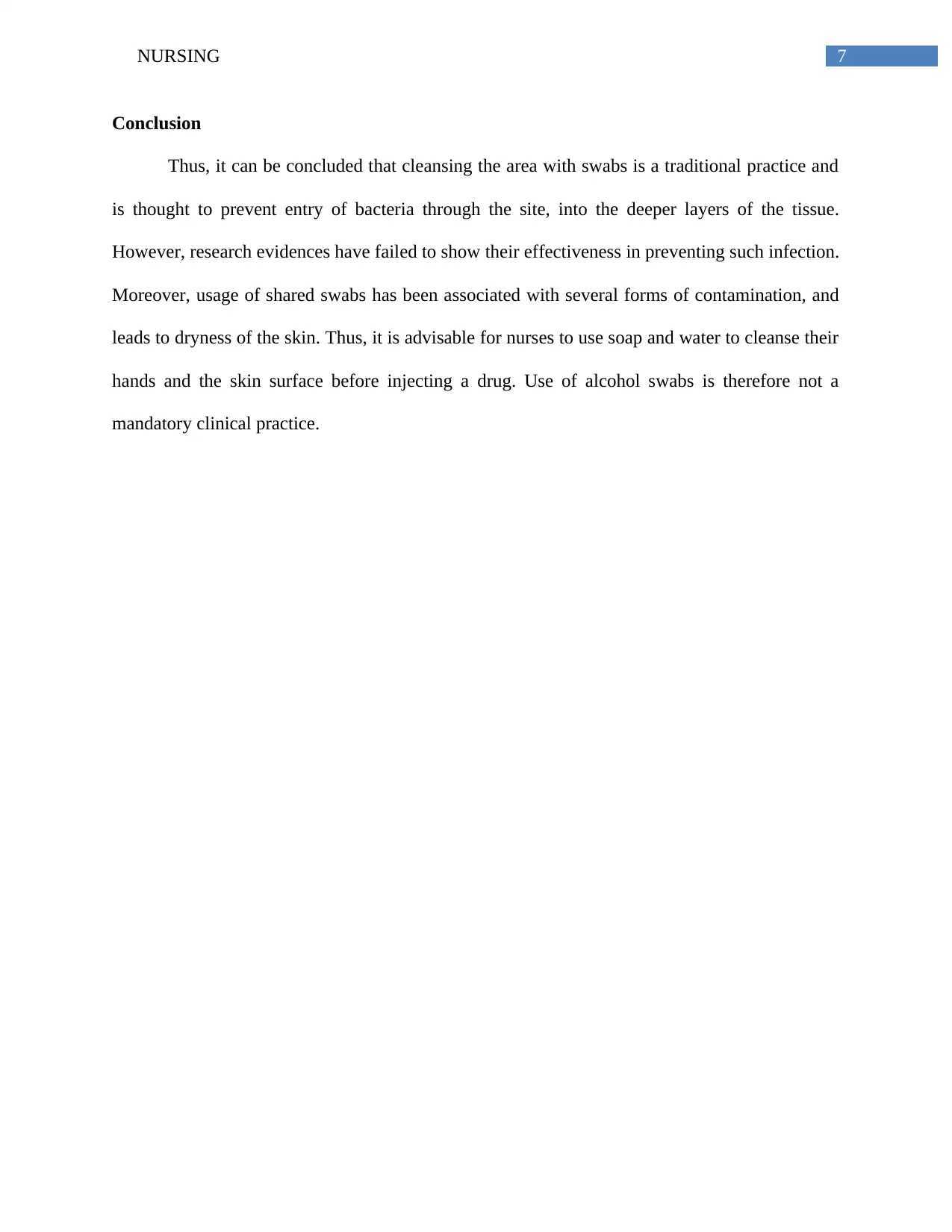
7NURSING
Conclusion
Thus, it can be concluded that cleansing the area with swabs is a traditional practice and
is thought to prevent entry of bacteria through the site, into the deeper layers of the tissue.
However, research evidences have failed to show their effectiveness in preventing such infection.
Moreover, usage of shared swabs has been associated with several forms of contamination, and
leads to dryness of the skin. Thus, it is advisable for nurses to use soap and water to cleanse their
hands and the skin surface before injecting a drug. Use of alcohol swabs is therefore not a
mandatory clinical practice.
Conclusion
Thus, it can be concluded that cleansing the area with swabs is a traditional practice and
is thought to prevent entry of bacteria through the site, into the deeper layers of the tissue.
However, research evidences have failed to show their effectiveness in preventing such infection.
Moreover, usage of shared swabs has been associated with several forms of contamination, and
leads to dryness of the skin. Thus, it is advisable for nurses to use soap and water to cleanse their
hands and the skin surface before injecting a drug. Use of alcohol swabs is therefore not a
mandatory clinical practice.
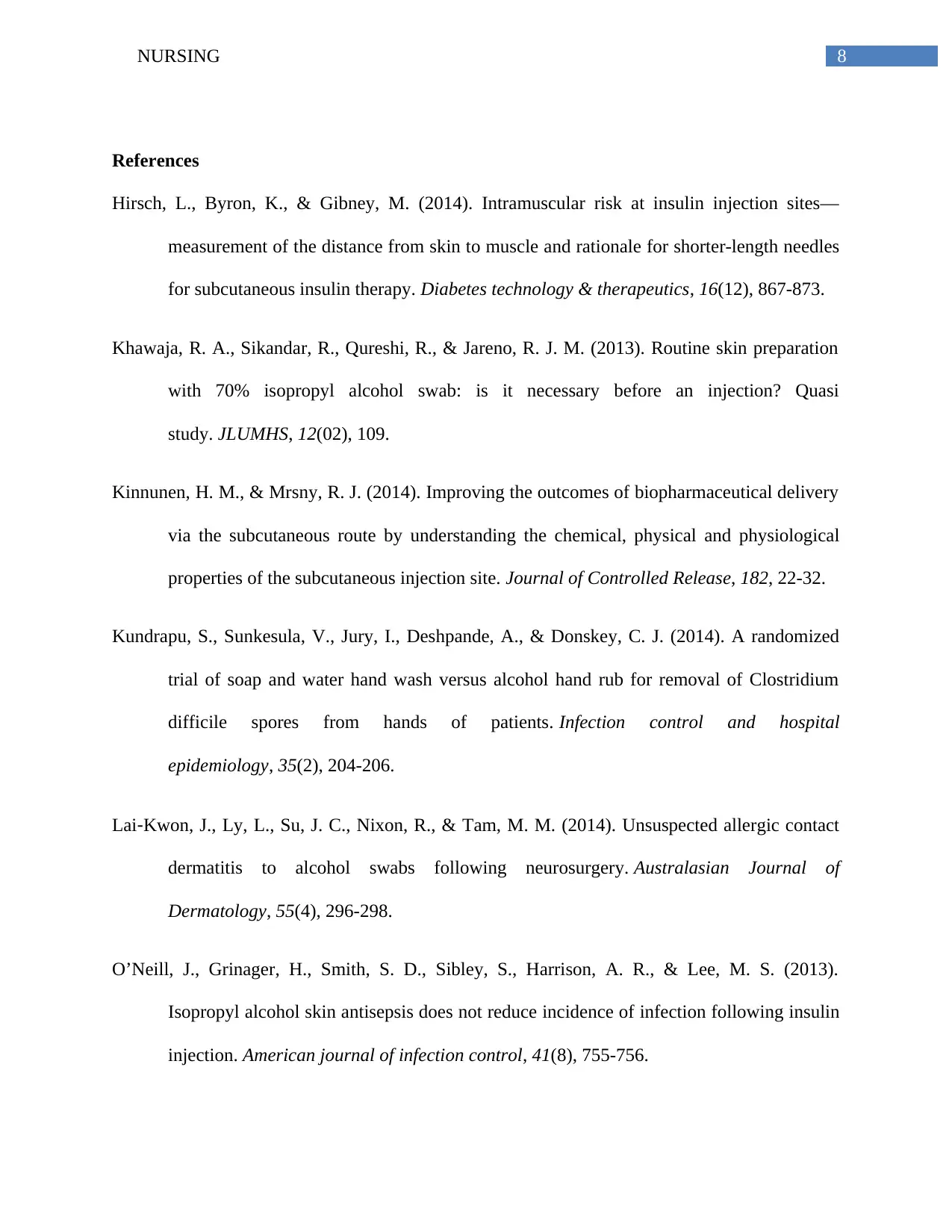
8NURSING
References
Hirsch, L., Byron, K., & Gibney, M. (2014). Intramuscular risk at insulin injection sites—
measurement of the distance from skin to muscle and rationale for shorter-length needles
for subcutaneous insulin therapy. Diabetes technology & therapeutics, 16(12), 867-873.
Khawaja, R. A., Sikandar, R., Qureshi, R., & Jareno, R. J. M. (2013). Routine skin preparation
with 70% isopropyl alcohol swab: is it necessary before an injection? Quasi
study. JLUMHS, 12(02), 109.
Kinnunen, H. M., & Mrsny, R. J. (2014). Improving the outcomes of biopharmaceutical delivery
via the subcutaneous route by understanding the chemical, physical and physiological
properties of the subcutaneous injection site. Journal of Controlled Release, 182, 22-32.
Kundrapu, S., Sunkesula, V., Jury, I., Deshpande, A., & Donskey, C. J. (2014). A randomized
trial of soap and water hand wash versus alcohol hand rub for removal of Clostridium
difficile spores from hands of patients. Infection control and hospital
epidemiology, 35(2), 204-206.
Lai‐Kwon, J., Ly, L., Su, J. C., Nixon, R., & Tam, M. M. (2014). Unsuspected allergic contact
dermatitis to alcohol swabs following neurosurgery. Australasian Journal of
Dermatology, 55(4), 296-298.
O’Neill, J., Grinager, H., Smith, S. D., Sibley, S., Harrison, A. R., & Lee, M. S. (2013).
Isopropyl alcohol skin antisepsis does not reduce incidence of infection following insulin
injection. American journal of infection control, 41(8), 755-756.
References
Hirsch, L., Byron, K., & Gibney, M. (2014). Intramuscular risk at insulin injection sites—
measurement of the distance from skin to muscle and rationale for shorter-length needles
for subcutaneous insulin therapy. Diabetes technology & therapeutics, 16(12), 867-873.
Khawaja, R. A., Sikandar, R., Qureshi, R., & Jareno, R. J. M. (2013). Routine skin preparation
with 70% isopropyl alcohol swab: is it necessary before an injection? Quasi
study. JLUMHS, 12(02), 109.
Kinnunen, H. M., & Mrsny, R. J. (2014). Improving the outcomes of biopharmaceutical delivery
via the subcutaneous route by understanding the chemical, physical and physiological
properties of the subcutaneous injection site. Journal of Controlled Release, 182, 22-32.
Kundrapu, S., Sunkesula, V., Jury, I., Deshpande, A., & Donskey, C. J. (2014). A randomized
trial of soap and water hand wash versus alcohol hand rub for removal of Clostridium
difficile spores from hands of patients. Infection control and hospital
epidemiology, 35(2), 204-206.
Lai‐Kwon, J., Ly, L., Su, J. C., Nixon, R., & Tam, M. M. (2014). Unsuspected allergic contact
dermatitis to alcohol swabs following neurosurgery. Australasian Journal of
Dermatology, 55(4), 296-298.
O’Neill, J., Grinager, H., Smith, S. D., Sibley, S., Harrison, A. R., & Lee, M. S. (2013).
Isopropyl alcohol skin antisepsis does not reduce incidence of infection following insulin
injection. American journal of infection control, 41(8), 755-756.
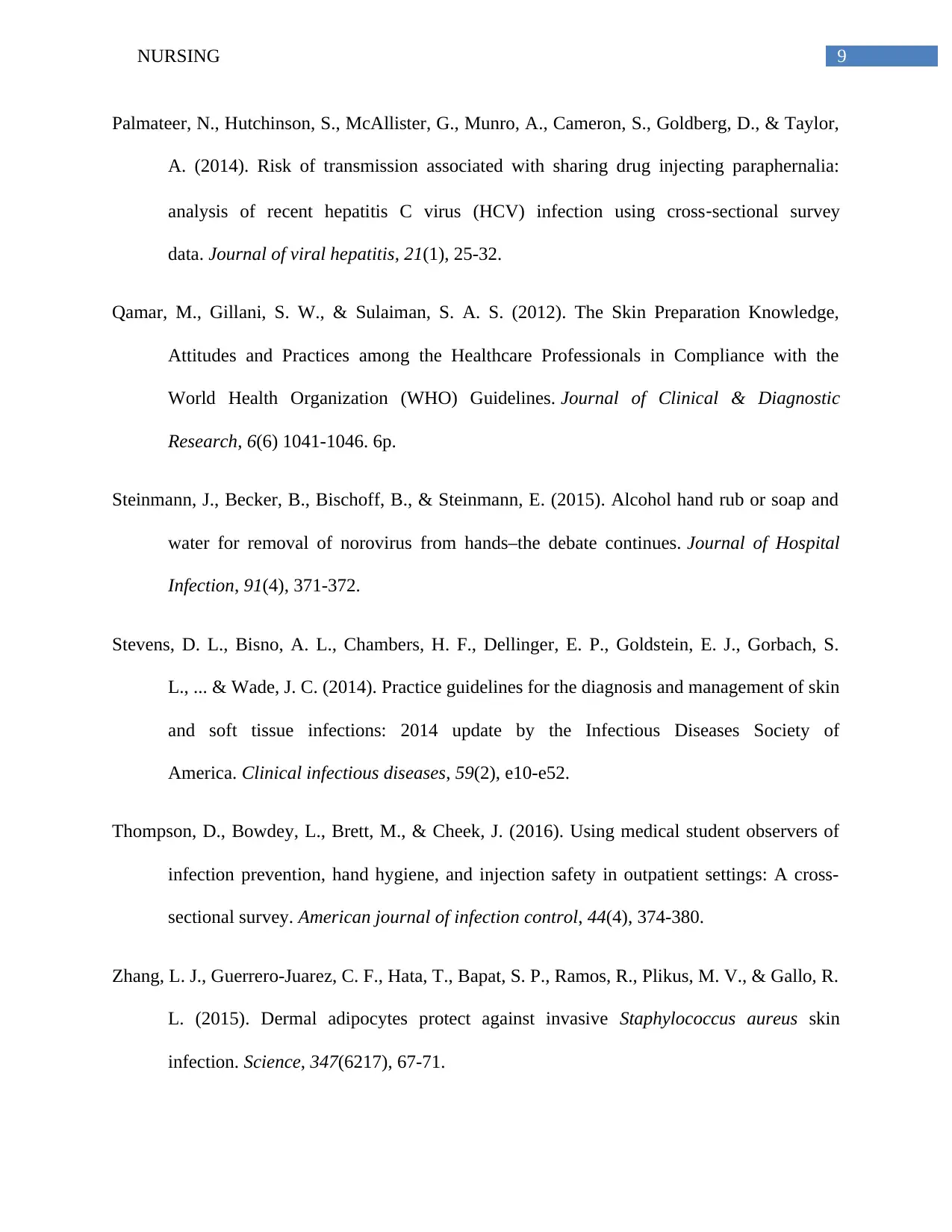
9NURSING
Palmateer, N., Hutchinson, S., McAllister, G., Munro, A., Cameron, S., Goldberg, D., & Taylor,
A. (2014). Risk of transmission associated with sharing drug injecting paraphernalia:
analysis of recent hepatitis C virus (HCV) infection using cross‐sectional survey
data. Journal of viral hepatitis, 21(1), 25-32.
Qamar, M., Gillani, S. W., & Sulaiman, S. A. S. (2012). The Skin Preparation Knowledge,
Attitudes and Practices among the Healthcare Professionals in Compliance with the
World Health Organization (WHO) Guidelines. Journal of Clinical & Diagnostic
Research, 6(6) 1041-1046. 6p.
Steinmann, J., Becker, B., Bischoff, B., & Steinmann, E. (2015). Alcohol hand rub or soap and
water for removal of norovirus from hands–the debate continues. Journal of Hospital
Infection, 91(4), 371-372.
Stevens, D. L., Bisno, A. L., Chambers, H. F., Dellinger, E. P., Goldstein, E. J., Gorbach, S.
L., ... & Wade, J. C. (2014). Practice guidelines for the diagnosis and management of skin
and soft tissue infections: 2014 update by the Infectious Diseases Society of
America. Clinical infectious diseases, 59(2), e10-e52.
Thompson, D., Bowdey, L., Brett, M., & Cheek, J. (2016). Using medical student observers of
infection prevention, hand hygiene, and injection safety in outpatient settings: A cross-
sectional survey. American journal of infection control, 44(4), 374-380.
Zhang, L. J., Guerrero-Juarez, C. F., Hata, T., Bapat, S. P., Ramos, R., Plikus, M. V., & Gallo, R.
L. (2015). Dermal adipocytes protect against invasive Staphylococcus aureus skin
infection. Science, 347(6217), 67-71.
Palmateer, N., Hutchinson, S., McAllister, G., Munro, A., Cameron, S., Goldberg, D., & Taylor,
A. (2014). Risk of transmission associated with sharing drug injecting paraphernalia:
analysis of recent hepatitis C virus (HCV) infection using cross‐sectional survey
data. Journal of viral hepatitis, 21(1), 25-32.
Qamar, M., Gillani, S. W., & Sulaiman, S. A. S. (2012). The Skin Preparation Knowledge,
Attitudes and Practices among the Healthcare Professionals in Compliance with the
World Health Organization (WHO) Guidelines. Journal of Clinical & Diagnostic
Research, 6(6) 1041-1046. 6p.
Steinmann, J., Becker, B., Bischoff, B., & Steinmann, E. (2015). Alcohol hand rub or soap and
water for removal of norovirus from hands–the debate continues. Journal of Hospital
Infection, 91(4), 371-372.
Stevens, D. L., Bisno, A. L., Chambers, H. F., Dellinger, E. P., Goldstein, E. J., Gorbach, S.
L., ... & Wade, J. C. (2014). Practice guidelines for the diagnosis and management of skin
and soft tissue infections: 2014 update by the Infectious Diseases Society of
America. Clinical infectious diseases, 59(2), e10-e52.
Thompson, D., Bowdey, L., Brett, M., & Cheek, J. (2016). Using medical student observers of
infection prevention, hand hygiene, and injection safety in outpatient settings: A cross-
sectional survey. American journal of infection control, 44(4), 374-380.
Zhang, L. J., Guerrero-Juarez, C. F., Hata, T., Bapat, S. P., Ramos, R., Plikus, M. V., & Gallo, R.
L. (2015). Dermal adipocytes protect against invasive Staphylococcus aureus skin
infection. Science, 347(6217), 67-71.
1 out of 10
Your All-in-One AI-Powered Toolkit for Academic Success.
+13062052269
info@desklib.com
Available 24*7 on WhatsApp / Email
![[object Object]](/_next/static/media/star-bottom.7253800d.svg)
Unlock your academic potential
© 2024 | Zucol Services PVT LTD | All rights reserved.